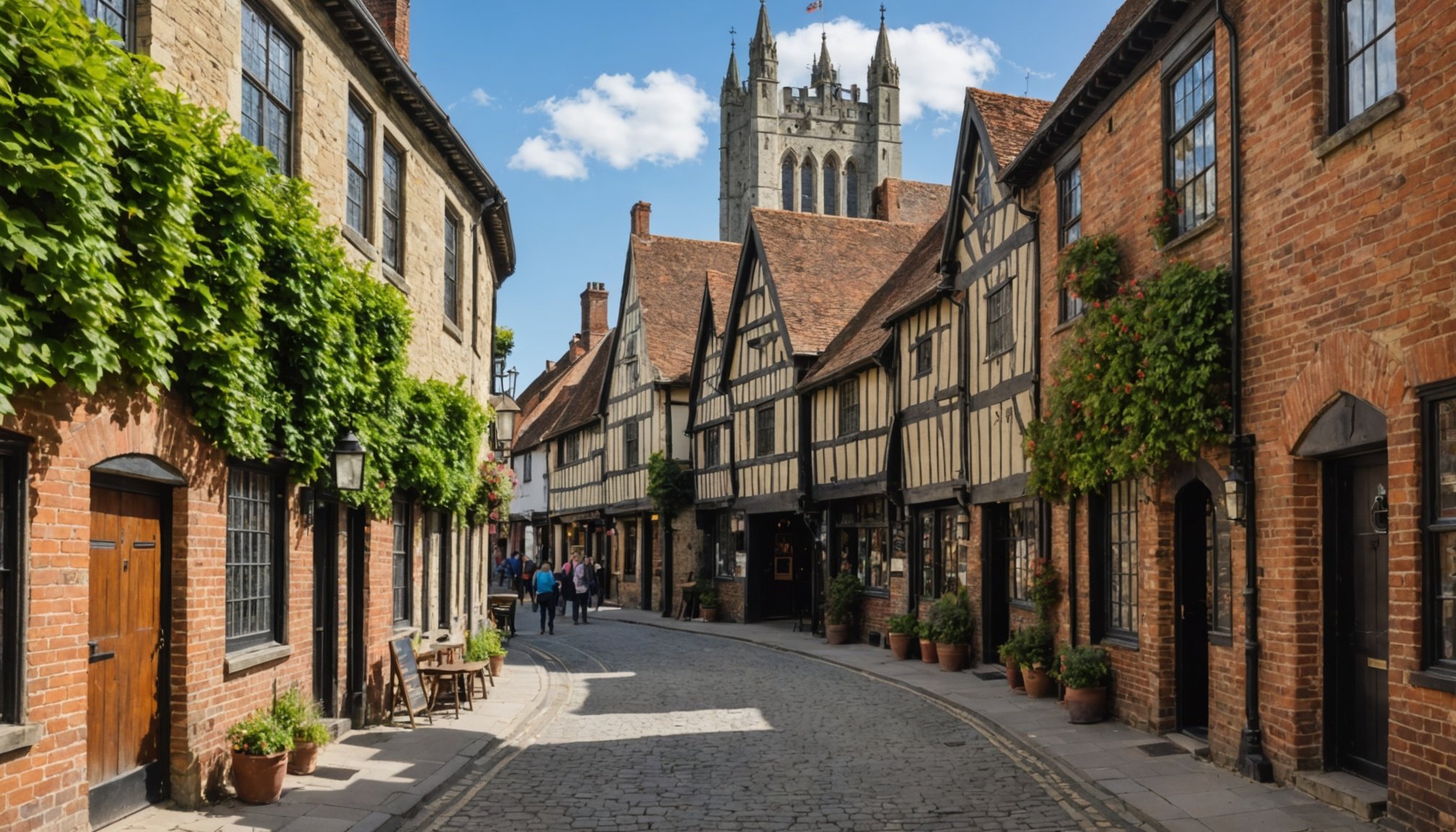Overview of Canterbury’s Historical Attractions
Canterbury entices visitors with its rich tapestry of historical attractions that offer captivating glimpses into the past. This city, boasting a profound historical context, invites explorers to immerse themselves in its landmarks. Amongst its most notable sites is Canterbury Cathedral, a beacon of Gothic architecture and spirituality. It’s a masterpiece that traces back to medieval times and played a pivotal role in English history. Wander through the ruins of St. Augustine’s Abbey to learn about the beginnings of English Christianity, adding layers to your understanding of the city’s historical context.
Guided tours are crucial in enriching your visit to these sites. These tours provide comprehensive narratives that enhance the experience, transforming each attraction visit from a simple sightseeing endeavor into an educational journey. Equipped with in-depth knowledge, guides unravel tales of the past, infusing life into stone and mortar. The advantage of guided tours lies in their ability to present historical context in an engaging and informative manner, ensuring every visitor walks away with a profound appreciation for Canterbury’s past. Whether you’re a history buff or a casual traveler, these tours are essential in connecting with the deep-rooted stories of Canterbury.
In parallel : Explore cornwall”s best coastal trails for dogs and their humans: ultimate guide to pet-friendly walks
Expert Guided Tours Available
Explore Canterbury through expert guided tours that promise an enlightening experience. These tours stand out by offering tailored insights and detailed narratives, revealing the city’s layered history. Taking part in a guided tour maximizes your visit, bringing history alive with stories and facts that aren’t easily found in guidebooks.
Types of Tours Offered
Canterbury tours present a range of tour options to suit various interests and schedules. From brisk 1-hour walks through medieval streets to comprehensive day-long journeys, there’s something for every history enthusiast. Many tours can be customized, allowing you to focus on particular eras or architectural styles. This level of personalization enhances your connection with historical landmarks.
Also to see : Uncover the most stunning picnic spots in the peak district: a nature lover”s guide
Qualifications of Expert Guides
Guides leading these tours are highly qualified, boasting backgrounds in historical education and extensive experience in Canterbury history. Their expertise is complemented by relevant certifications, ensuring an authoritative and informative tour. Testimonials frequently highlight their professionalism and engaging storytelling skills, enhancing visitors’ understanding and appreciation of the city.
User Reviews and Experiences
Participants consistently praise the cultural depth delivered through guided tours. Positive feedback emphasizes the tours’ educational value, often crediting guides for their insights and approachability. Some areas for improvement include increasing tour frequency and providing more interactive elements within tours. Overall, these experiences enrich appreciation for Canterbury’s historical significance.
Pricing and Booking Information
Navigating the tour pricing for Canterbury’s rich historical offers can be straightforward with the right information at your fingertips. Average costs for Canterbury tours can vary, typically ranging from modest rates for short, educational walks to higher rates for in-depth, full-day experiences. Each option offers a unique glimpse into the city’s storied past.
There are often discounts available, especially for those who book early; these promotions can provide significant savings and are a great incentive for advance planning. Keep an eye out for family packages and seasonal offers which provide excellent value for money.
Booking a tour is a simple process usually conducted online via tour operators’ websites. Follow these steps for a hassle-free experience:
- Explore available tours and decide which matches your interests and schedule.
- Select your preferred date and time.
- Add any additional services, such as private guides or group discounts.
- Proceed to checkout and complete the booking by entering your payment details.
Understanding these aspects of tour pricing and planning ensures a seamless and rewarding historical journey through Canterbury’s cherished sites.
Recommended Historical Sites to Visit
To experience Canterbury’s wealth of must-see attractions, a curated list of historic sites in Canterbury is essential. The Canterbury Cathedral, renowned for its stunning Gothic architecture, is a visitor favourite, embodying centuries of religious and architectural heritage. St. Augustine’s Abbey, another gem, provides insight into the earliest phases of English Christianity.
The Eastbridge Hospital, a medieval pilgrim hospital, offers a unique perspective into the lives of those who travelled to Canterbury long ago. Visiting the Westgate Towers, the city’s fortified western gateway, enhances understanding of medieval fortifications.
Pairing these sites with specific tours can deepen appreciation and insight. For instance, combine visits to Canterbury Cathedral and St. Augustine’s Abbey on a themed tour focusing on ecclesiastical history. This approach maximizes learning and appreciation, with expert guided tours offering context and interpretation.
Exploring these sites reveals not just Canterbury’s history but also underlines their significance in the broader tapestry of English heritage. Engaging with guided tours ensures that these landmarks are not just visited but understood and appreciated, enriching the historical journey.
Visuals and Maps of Attractions
Visual aids are invaluable tools when planning a visit to Canterbury’s historical attractions. Offering a tangible perspective, these aids enhance a visitor’s understanding and navigation throughout the city. Attraction maps are particularly useful, providing a clear layout of Canterbury’s most important sites. They allow you to efficiently plan your route, ensuring you make the most of your time exploring.
Many guided tours in Canterbury include detailed historical maps, highlighting significant landmarks and their interconnections. These maps often feature layered information, illustrating the historical context of specific areas and their evolution over time. Such visual storytelling enriches the visitor experience, making history more accessible and engaging.
Sample images and maps are commonly available through tour providers and local visitor centres. They can spotlight key architectural features or offer a bird’s-eye view of historic sites in Canterbury. These visual tools are often paired with informative guides who use them to provide a deeper insight into the locale’s heritage.
Overall, leveraging visual aids ensures visitors are not only informed beforehand but fully immersed in the rich historical tapestry during their journey through Canterbury.
Historical Context of Canterbury
Delving into Canterbury history offers a profound comprehension of its enduring legacy. This city has been a pivotal site in England’s historical narrative, tracing its roots back to the Roman era. Noteworthy is its evolution from a Roman outpost to a bustling medieval town. Key historical events such as the establishment of St. Augustine’s Abbey around 597 AD marked the city’s significance in spreading Christianity across England.
A prominent turning point was the martyrdom of Archbishop Thomas Becket in 1170 within Canterbury Cathedral, an event that drew pilgrims and significantly influenced British history. These instances underline the city’s historical significance, woven through monuments and stories that continue to resonate today.
Preserving historical context in guided tours is crucial. It enriches the visitor experience by connecting them with the city’s storied past. For instance, expert guides portray the intricacies of medieval life, ensuring the history remains accessible and vibrant. By conveying these narratives, they maintain the integrity of Canterbury’s heritage, deeply enhancing our understanding and appreciation of each landmark’s role in shaping not just the city, but the broader history of England.











